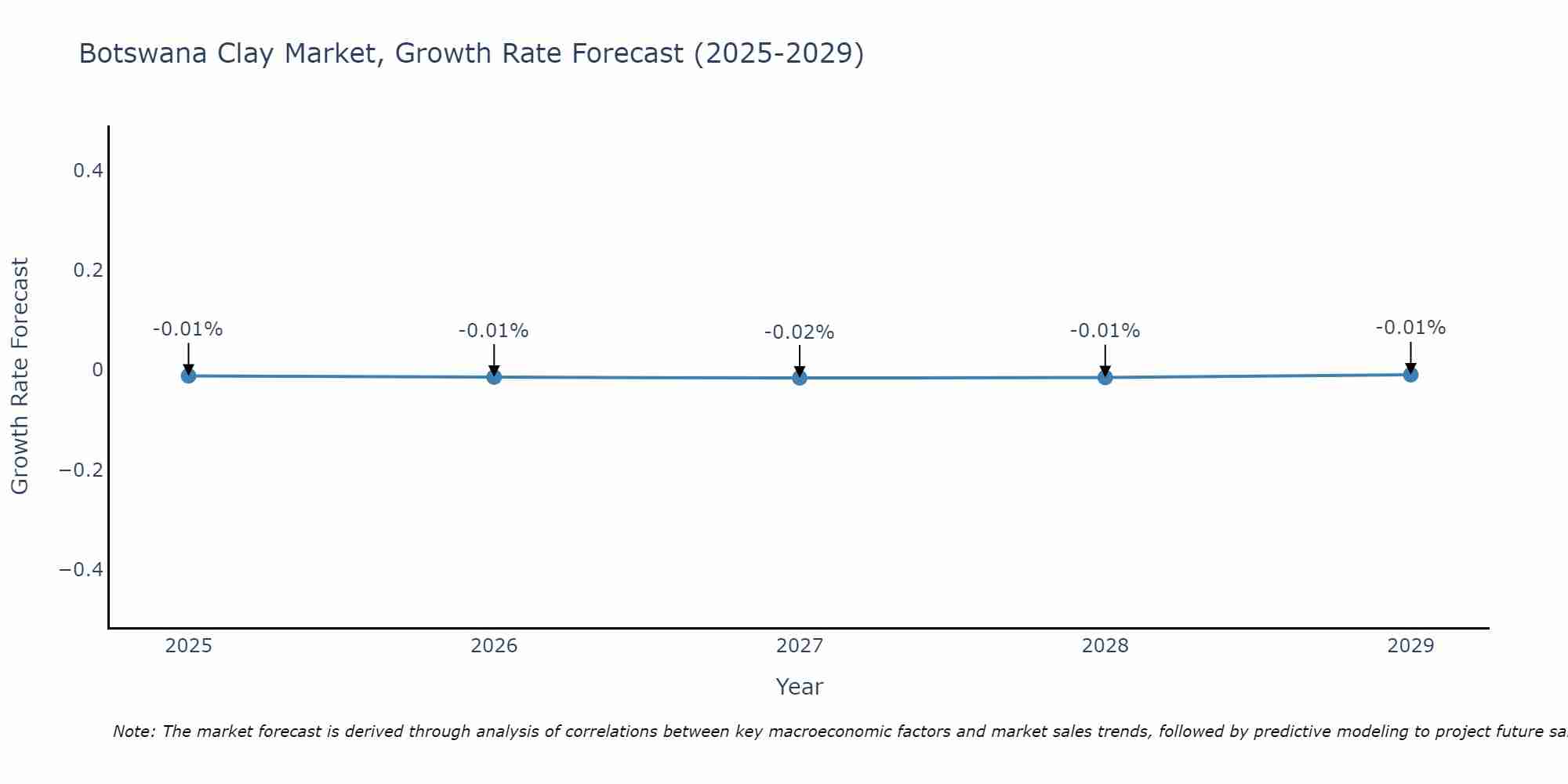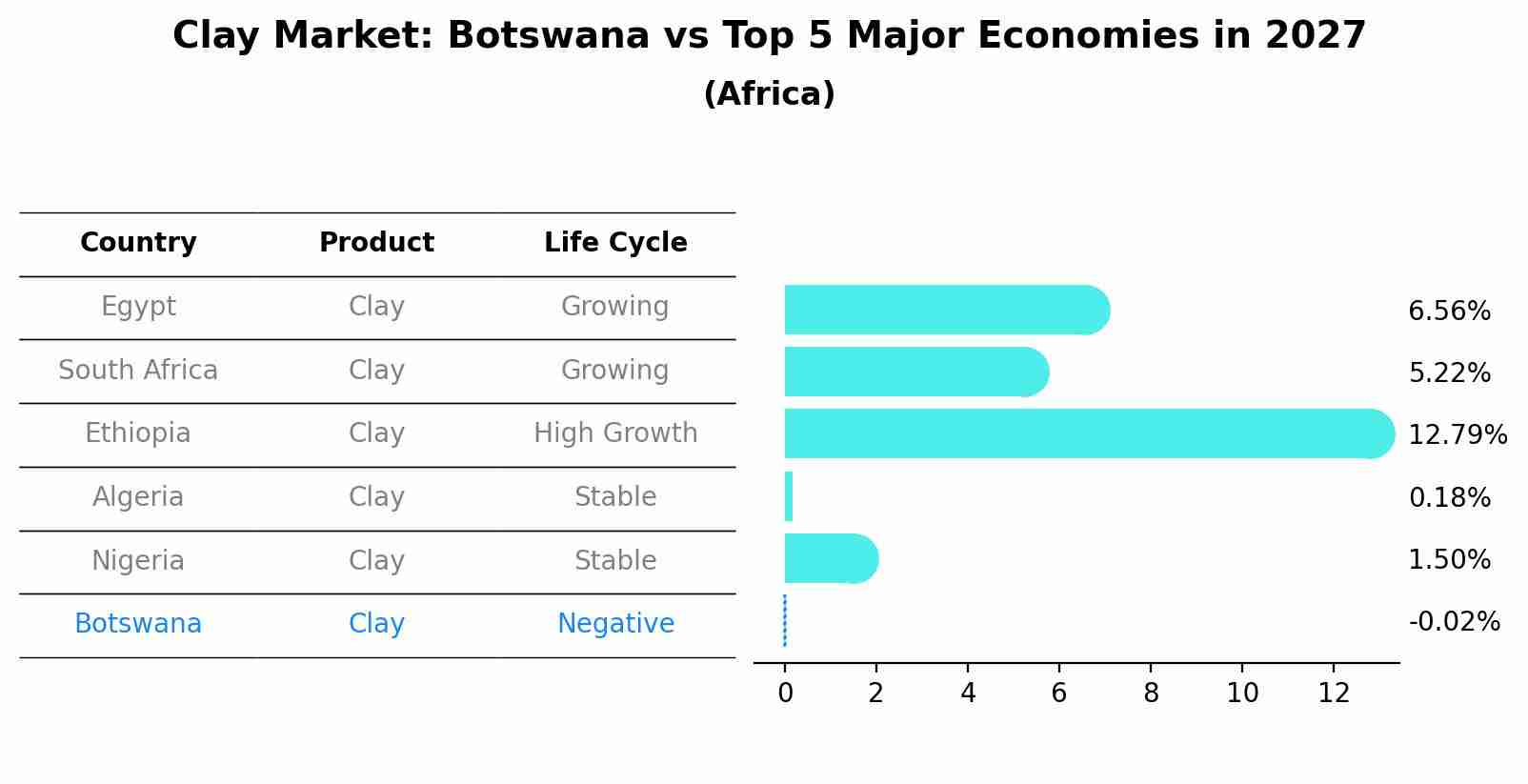Botswana Clay Market (2025-2031) | Trends, Analysis, Outlook, Share, Segmentation, Industry, Growth, Revenue, Size, Value, Companies & Forecast
| Product Code: ETC5257632 | Publication Date: Nov 2023 | Updated Date: Oct 2025 | Product Type: Market Research Report | |
| Publisher: 6Wresearch | Author: Bhawna Singh | No. of Pages: 60 | No. of Figures: 30 | No. of Tables: 5 |
Botswana Clay Market Size Growth Rate
The Botswana Clay Market is projected to witness mixed growth rate patterns during 2025 to 2029. The growth rate starts at -0.01% in 2025 and reaches -0.01% by 2029.

Clay Market: Botswana vs Top 5 Major Economies in 2027 (Africa)
By 2027, Botswana's Clay market is forecasted to achieve a negative growth rate of -0.02%, with Egypt leading the Africa region, followed by South Africa, Ethiopia, Algeria and Nigeria.

Botswana Clay Market Overview
The clay market in Botswana is expanding, driven by its use in various industries such as ceramics, construction, and agriculture. Clay is valued for its versatility and applications in making pottery, bricks, and as a soil conditioner. Market growth is supported by increasing industrial activities and demand for clay-based products. Innovations in clay processing and applications are enhancing its market appeal and contributing to development.
Drivers of the market
The clay market in Botswana is growing due to its applications in construction, ceramics, and industrial processes. Clay is used for making bricks, tiles, pottery, and as a raw material in various manufacturing processes. The market is driven by the expanding construction industry, increasing demand for ceramic products, and rising industrial activities. Technological advancements in clay processing and the development of high-quality and specialized clay products are enhancing market growth.
Challenges of the market
The clay market in Botswana faces challenges related to the limited scale of the local construction, ceramics, and industrial sectors, which are the primary consumers of clay. High import costs and the lack of local processing capabilities further constrain the market. Additionally, the market is affected by competition from alternative materials, such as concrete and synthetic polymers, which may offer similar properties at a lower cost or with better performance characteristics.
Government Policy of the market
The clay market in Botswana is shaped by government policies related to mining and construction materials. Policies that support the extraction and use of clay in various applications, such as construction and ceramics, drive market growth. Government initiatives aimed at improving mining infrastructure and promoting sustainable practices contribute to market development. Additionally, regulations concerning environmental impact and import tariffs affect market dynamics.
Key Highlights of the Report:
- Botswana Clay Market Outlook
- Market Size of Botswana Clay Market, 2024
- Forecast of Botswana Clay Market, 2031
- Historical Data and Forecast of Botswana Clay Revenues & Volume for the Period 2021-2031
- Botswana Clay Market Trend Evolution
- Botswana Clay Market Drivers and Challenges
- Botswana Clay Price Trends
- Botswana Clay Porter`s Five Forces
- Botswana Clay Industry Life Cycle
- Historical Data and Forecast of Botswana Clay Market Revenues & Volume By Application for the Period 2021-2031
- Historical Data and Forecast of Botswana Clay Market Revenues & Volume By Tableware for the Period 2021-2031
- Historical Data and Forecast of Botswana Clay Market Revenues & Volume By Sanitary ware for the Period 2021-2031
- Historical Data and Forecast of Botswana Clay Market Revenues & Volume By Medical applications for the Period 2021-2031
- Historical Data and Forecast of Botswana Clay Market Revenues & Volume By End Use for the Period 2021-2031
- Historical Data and Forecast of Botswana Clay Market Revenues & Volume By Ceramic and for the Period 2021-2031
- Historical Data and Forecast of Botswana Clay Market Revenues & Volume By Non-ceramic for the Period 2021-2031
- Botswana Clay Import Export Trade Statistics
- Market Opportunity Assessment By Application
- Market Opportunity Assessment By End Use
- Botswana Clay Top Companies Market Share
- Botswana Clay Competitive Benchmarking By Technical and Operational Parameters
- Botswana Clay Company Profiles
- Botswana Clay Key Strategic Recommendations
Frequently Asked Questions About the Market Study (FAQs):
1 Executive Summary |
2 Introduction |
2.1 Key Highlights of the Report |
2.2 Report Description |
2.3 Market Scope & Segmentation |
2.4 Research Methodology |
2.5 Assumptions |
3 Botswana Clay Market Overview |
3.1 Botswana Country Macro Economic Indicators |
3.2 Botswana Clay Market Revenues & Volume, 2021 & 2031F |
3.3 Botswana Clay Market - Industry Life Cycle |
3.4 Botswana Clay Market - Porter's Five Forces |
3.5 Botswana Clay Market Revenues & Volume Share, By Application, 2021 & 2031F |
3.6 Botswana Clay Market Revenues & Volume Share, By End Use, 2021 & 2031F |
4 Botswana Clay Market Dynamics |
4.1 Impact Analysis |
4.2 Market Drivers |
4.2.1 Increasing construction activities in Botswana leading to higher demand for clay for bricks, tiles, and other construction materials. |
4.2.2 Growing investments in infrastructure development projects driving the demand for clay products. |
4.2.3 Rising awareness about the benefits of using clay-based products in sustainable construction practices. |
4.3 Market Restraints |
4.3.1 Fluctuations in raw material prices impacting the production cost of clay products. |
4.3.2 Environmental regulations and sustainability concerns affecting the extraction and processing of clay. |
4.3.3 Competition from alternative building materials impacting the market share of clay products. |
5 Botswana Clay Market Trends |
6 Botswana Clay Market Segmentations |
6.1 Botswana Clay Market, By Application |
6.1.1 Overview and Analysis |
6.1.2 Botswana Clay Market Revenues & Volume, By Tableware, 2021-2031F |
6.1.3 Botswana Clay Market Revenues & Volume, By Sanitary ware, 2021-2031F |
6.1.4 Botswana Clay Market Revenues & Volume, By Medical applications, 2021-2031F |
6.2 Botswana Clay Market, By End Use |
6.2.1 Overview and Analysis |
6.2.2 Botswana Clay Market Revenues & Volume, By Ceramic and, 2021-2031F |
6.2.3 Botswana Clay Market Revenues & Volume, By Non-ceramic, 2021-2031F |
7 Botswana Clay Market Import-Export Trade Statistics |
7.1 Botswana Clay Market Export to Major Countries |
7.2 Botswana Clay Market Imports from Major Countries |
8 Botswana Clay Market Key Performance Indicators |
8.1 Number of new construction projects initiated in Botswana. |
8.2 Percentage increase in infrastructure spending in Botswana. |
8.3 Adoption rate of clay-based products in construction projects. |
8.4 Average lead time from clay extraction to product manufacturing. |
8.5 Rate of return on investment in clay mining and processing operations. |
9 Botswana Clay Market - Opportunity Assessment |
9.1 Botswana Clay Market Opportunity Assessment, By Application, 2021 & 2031F |
9.2 Botswana Clay Market Opportunity Assessment, By End Use, 2021 & 2031F |
10 Botswana Clay Market - Competitive Landscape |
10.1 Botswana Clay Market Revenue Share, By Companies, 2024 |
10.2 Botswana Clay Market Competitive Benchmarking, By Operating and Technical Parameters |
11 Company Profiles |
12 Recommendations | 13 Disclaimer |
- Single User License$ 1,995
- Department License$ 2,400
- Site License$ 3,120
- Global License$ 3,795
Search
Related Reports
- ASEAN and Thailand Brain Health Supplements Market (2025-2031) | Strategy, Consumer Insights, Analysis, Investment Trends, Opportunities, Growth, Size, Share, Industry, Revenue, Segments, Value, Segmentation, Supply, Forecast, Restraints, Outlook, Competition, Drivers, Trends, Demand, Pricing Analysis, Competitive, Strategic Insights, Companies, Challenges
- ASEAN Bearings Market (2025-2031) | Strategy, Consumer Insights, Analysis, Investment Trends, Opportunities, Growth, Size, Share, Industry, Revenue, Segments, Value, Segmentation, Supply, Forecast, Restraints, Outlook, Competition, Drivers, Trends, Demand, Pricing Analysis, Competitive, Strategic Insights, Companies, Challenges
- Europe Flooring Market (2025-2031) | Outlook, Share, Industry, Trends, Forecast, Companies, Revenue, Size, Analysis, Growth & Value
- Saudi Arabia Manlift Market (2025-2031) | Outlook, Size, Growth, Trends, Companies, Industry, Revenue, Value, Share, Forecast & Analysis
- Uganda Excavator, Crane, and Wheel Loaders Market (2025-2031) | Strategy, Consumer Insights, Analysis, Investment Trends, Opportunities, Growth, Size, Share, Industry, Revenue, Segments, Value, Segmentation, Supply, Forecast, Restraints, Outlook, Competition, Drivers, Trends, Demand, Pricing Analysis, Competitive, Strategic Insights, Companies, Challenges
- Rwanda Excavator, Crane, and Wheel Loaders Market (2025-2031) | Strategy, Consumer Insights, Analysis, Investment Trends, Opportunities, Growth, Size, Share, Industry, Revenue, Segments, Value, Segmentation, Supply, Forecast, Restraints, Outlook, Competition, Drivers, Trends, Demand, Pricing Analysis, Competitive, Strategic Insights, Companies, Challenges
- Kenya Excavator, Crane, and Wheel Loaders Market (2025-2031) | Strategy, Consumer Insights, Analysis, Investment Trends, Opportunities, Growth, Size, Share, Industry, Revenue, Segments, Value, Segmentation, Supply, Forecast, Restraints, Outlook, Competition, Drivers, Trends, Demand, Pricing Analysis, Competitive, Strategic Insights, Companies, Challenges
- Angola Excavator, Crane, and Wheel Loaders Market (2025-2031) | Strategy, Consumer Insights, Analysis, Investment Trends, Opportunities, Growth, Size, Share, Industry, Revenue, Segments, Value, Segmentation, Supply, Forecast, Restraints, Outlook, Competition, Drivers, Trends, Demand, Pricing Analysis, Competitive, Strategic Insights, Companies, Challenges
- Israel Intelligent Transport System Market (2025-2031) | Strategy, Consumer Insights, Analysis, Investment Trends, Opportunities, Growth, Size, Share, Industry, Revenue, Segments, Value, Segmentation, Supply, Forecast, Restraints, Outlook, Competition, Drivers, Trends, Demand, Pricing Analysis, Competitive, Strategic Insights, Companies, Challenges
- Uganda Precast and Aggregate Market (2025-2031) | Strategy, Consumer Insights, Analysis, Investment Trends, Opportunities, Growth, Size, Share, Industry, Revenue, Segments, Value, Segmentation, Supply, Forecast, Restraints, Outlook, Competition, Drivers, Trends, Demand, Pricing Analysis, Competitive, Strategic Insights, Companies, Challenges
Industry Events and Analyst Meet
Our Clients
Whitepaper
- Middle East & Africa Commercial Security Market Click here to view more.
- Middle East & Africa Fire Safety Systems & Equipment Market Click here to view more.
- GCC Drone Market Click here to view more.
- Middle East Lighting Fixture Market Click here to view more.
- GCC Physical & Perimeter Security Market Click here to view more.
6WResearch In News
- Doha a strategic location for EV manufacturing hub: IPA Qatar
- Demand for luxury TVs surging in the GCC, says Samsung
- Empowering Growth: The Thriving Journey of Bangladesh’s Cable Industry
- Demand for luxury TVs surging in the GCC, says Samsung
- Video call with a traditional healer? Once unthinkable, it’s now common in South Africa
- Intelligent Buildings To Smooth GCC’s Path To Net Zero













